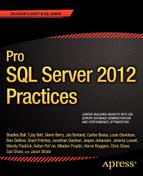Contents
![]() Chapter 1: Be Your Developer’s Best Friend
Chapter 1: Be Your Developer’s Best Friend
My Experience Working with SQL Server and Developers
Reconciling Different Viewpoints Within an Organization
Preparing to Work with Developers to Implement Changes to a System
Step 2: Describe the New Environment
Step 3: Create a Clear Document
Step 4: Create System-Management Procedures
Ensuring Version Compatibility
![]() Chapter 2: Getting It Right: Designing the Database for Performance
Chapter 2: Getting It Right: Designing the Database for Performance
A Really Quick Taste of History
Why a Normal Database Is Better Than an Extraordinary One
![]() Chapter 3: Hidden Performance Gotchas
Chapter 3: Hidden Performance Gotchas
![]() Chapter 4: Dynamic Management Views
Chapter 4: Dynamic Management Views
Common Performance-Tuning Queries
Retrieving Connection Information
Showing Currently Executing Requests
Using the Power of DMV Performance Scripts
System Performance Tuning Queries
What You Need to Know About System Performance DMVs
Sessions and Percentage Complete
![]() Chapter 5: From SQL Trace to Extended Events
Chapter 5: From SQL Trace to Extended Events
![]() Chapter 6: The Utility Database
Chapter 6: The Utility Database
Using Data Referential Integrity
Managing Key Business Indicators
Automating the Data Collection
Scheduling the Data Collection
![]() Chapter 7: Indexing Outside the Bubble
Chapter 7: Indexing Outside the Bubble
Release Plan Template and Release Plans
![]() Chapter 9: Compliance and Auditing
Chapter 9: Compliance and Auditing
Health Insurance Portability and Accountability Act
New Auditing Features in SQL Server 2012
Server-Level Auditing for the Standard Edition
Pro Tip: Alert on Audit Events
![]() Chapter 10: Automating Administration
Chapter 10: Automating Administration
SQL Server Integration Services
![]() Chapter 11: The Fluid Dynamics of SQL Server Data Movement
Chapter 11: The Fluid Dynamics of SQL Server Data Movement
Why the Need for Replicating Data?
Custom ETL Using SQL Server Integration Services
![]() Chapter 12: Windows Azure SQL Database for DBAs
Chapter 12: Windows Azure SQL Database for DBAs
Troubleshooting Performance Issues
![]() Chapter 13: I/O: The Untold Story
Chapter 13: I/O: The Untold Story
![]() Chapter 14: Page and Row Compression
Chapter 14: Page and Row Compression
What to Compress and How to Compress It
Fragmentation and Logged Operations
![]() Chapter 15: Selecting and Sizing the Server
Chapter 15: Selecting and Sizing the Server
SQL Server 2012 Enterprise Edition Consideration Factors
Server Processor Count Selection
Dell 12th Generation Server Comparison
![]() Chapter 16: Backups and Restores Using Availability Groups
Chapter 16: Backups and Restores Using Availability Groups
Setting Up an Availability Group
Configuring the Windows Server
Enabling Backups on Availability Groups
Automating Backups on Availability Groups
Recovery on Availability Groups
![]() Chapter 17: Big Data for the SQL Server DBA
Chapter 17: Big Data for the SQL Server DBA
MapReduce: The Nucleus of Hadoop
Big Data in the Microsoft Future
![]() Chapter 18: Tuning for Peak Load
Chapter 18: Tuning for Peak Load
Analyzing Application-Usage Data
